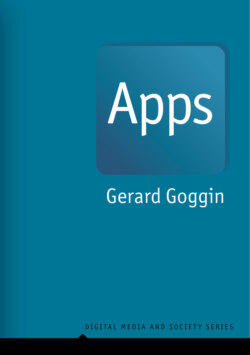Читать книгу Apps - Gerard Goggin - Страница 15
Conclusion: “There’s an App for That”
ОглавлениеApp stores mean little without the apps themselves. The sheer number of apps launched in the 2008–2013 period was extraordinary.
In the vanguard of apps, users were young users—a feature captured by the label “the app generation” (Gardner & Davis, 2013). While we need to be wary of the recurrent rhetoric of generations and technology (Goggin & Crawford, 2011) as well as of the diversity of the people gathered under the banner of “youth,” it is evident that young users were key to the take-up of mobile Internet, and then to the development of mobile media cultures—apps being center stage in that process (Stald, 2008). Social media apps on smartphones were especially influential in the appification of digital media and society in this new phase (Goggin, 2014). In many ways, via young users, social media apps become “anchor” software for the explosion of app-centered smartphone cultures that extended to almost inconceivable lengths. The role of apps in youth cultures and in the lives of young people was quickly established as an important area for consideration, typically possessed of ambiguity and contradictions that could unfold quite differently across the borders and boundaries of different apps, subcultures, social locations, and local and transnational dynamics (Goodyear et al., 2019; Li et al., 2020; Jin & Yoon, 2016; Mihailidis, 2014).
Apps and their users are much younger than computer software previously had—or Internet or mobile phone applications, for that matter. Children figured prominently as mobile phone users, as the technology became more widespread. This trend accelerated with smartphones, but very young children became avid users of apps—and fast created a profitable market for app developers and app stores. Adults came to rely on apps to “babysit” children; thus apps displaced television from this role. Apps also became a byword for parental anxieties about the negative effects of overabsorption in digital media devices and cultures. It’s fair to say that such anxieties are neither universal or general. As Shakuntala Banaji points out in her study of media-rich and media-deprived children in urban and rural settings in India, how we understand agency and cultural meaning depends on pivotal conditions such as class, responsibilities, labor, and knowledge (Banaji, 2015).
Once apps were domesticated by their child, adolescent, and young adult users (Haddon et al., 2005), typically in global North contexts, they became a staple of education—a linchpin of online and blended learning, pedagogy, and school as well as of further education, information education, and university education. Apps also became a new social and regulatory interface, stitching parents into the fabric of their children’s schooling, as laid out by Lim Sun Sun in her 2020 book Transcendental Parenting (Lim, 2020). School apps allowed parents to follow the timetable and progress of lessons and homework at a minute level, eavesdropping on the incidental and consequential communication between pupils and their teachers. As children’s media research shows us, the absorption of apps into the economies and relations of families and the roles of these technologies are themes that need careful unpicking (Clark, 2013; Livingstone & Blum-Ross, 2020).
Children and young people were only one group in an increasingly wide range of users who experimented with apps. Apps succeeded in delivering on many of the promises of earlier architects and promoters of technologies and imaginaries such as pervasive and ubiquitous computing, multimedia, and personalized media. They could deliver hypermedia to the person, engaging her or his identity, senses, and emotions in customized ways, which could be further refined via the reams of data that various apps were able to funnel and harvest. Along with smartphones, apps began to acquire status as a “go-to” zone where design was attractive, effective, and user-friendly, innovation brimmed over, and problems could be solved (or at least tackled). This techno-optimistic view of apps was summed up in a famous phrase. In early 2009, Apple and AT&T released a TV commercial that introduced the phrase “there’s an app for that”:
What’s great about the iPhone is that if you want to check snow conditions on the mountain, there’s an app for that. If you want to check how many calories are in your lunch, there’s an app for that. And if you want to check where exactly you parked the car, there’s an app for that. Yup, there’s an app for just about anything. (Apple & AT&T, 2009)
Hot on the heels of this advertisement were the parody ads, for example this mock ad from the US-based multicultural troupe the Latino Comedy Project, which imagines iPhone users crossing the Mexico–US border:
Say you’re not quite legal, but you need to get to El Norte without running into La Migra and or the drug cartels, there’s an app for that. What if you need to find the biggest holes in the fence, not covered by 24-hour surveillance, well, there’s an app for that too. Need to calculate a bribe for border guards, or coyotes? There’s even an app for that. (Latino Comedy Project, 2009, 0:01–0:21)
With the official and popular meanings of apps crisscrossing, the word “apps” was well on its way to having an altered meaning, associated with mobile phone apps and the many kinds of things they could possibly do.
With an understanding of the fundamentals and emergence of apps, we will step back in chapter 3 to gain a macro view of the economies and industries of apps by looking at the systems and structures of ownership, control, and power that shape how apps are made and circulated, where they fit into social life, and what options they offer and allow their users.
